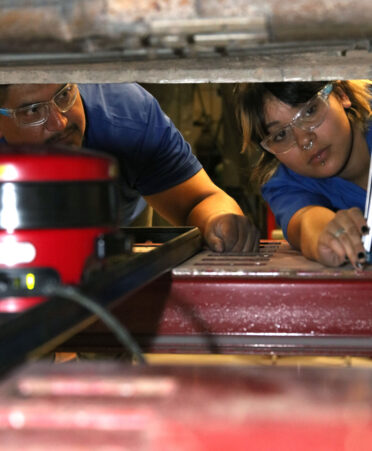(HARLINGEN, Texas) – Modern technology is reshaping the automotive body repair industry, and that impacts how future automotive body repairers are trained.
Jose Vasquez is the Auto Collision and Management Technology program director at Texas State Technical College’s Harlingen campus. Recently he talked about how some of the industry’s new technology is enhancing students’ skills.
Which components of computerized diagnostics are students learning?
The students learn about how to scan computer modules, air bag systems, anti-lock braking systems, and any type of fault such as overheating. They are able to identify a sensor or module issue by using a computerized diagnostic tool. That tool will recognize if the problem is an electrical issue or a different matter.
The students are amazed with the results because it helps them to troubleshoot and identify the electrical component that needs to be resolved.
What is spot welding, and how does it work?
Spot welding is a robot arm that’s controlled by a trigger that duplicates welds such as when an automobile is being produced in a factory. The process is much faster and cleaner. The automotive industry recommends it be used to be more productive for welding or putting panels together.
The students are adapting because there is a process to this technology. They review different settings and adjustments that have to be applied to the machine. After reviewing it, the students comprehend how to use the tool and set it up to perform the welds.
How do computer-aided design and computer-aided manufacturing factor into the auto body repair process?
These computer-aided programs use a 3D model comparison that measures an automobile’s specifications and provides feedback based on what is not correct. Our students enjoy that it’s user-friendly and provides information about how to make necessary automotive repairs.
Why is frame measurement important for an automobile?
When a vehicle has structural damage due to an auto collision, the manufacturer recommends that a frame measurement be completed. After the measurements have been gathered, tolerances are listed for each manufacturer’s specifications.
Our students follow the measurements and perform structural pulls or repairs and pull on any areas that are damaged. They do the replacement and remove damaged parts. Then they apply new parts and remeasure to ensure everything is aligned to specifications.
What is the importance of painting technology in auto body repair?
After repairs are finished, a painter has the important duty to make sure a paint job is top-notch. In our program, each student practices on spray panels. They follow a paint formula that corresponds to a specific automobile. They proceed to make the vehicle’s paint color and test it. If it doesn’t match, a student will refer back to the paint formula and use different toners to best match the original color.
According to onetonline.org, automotive body and related repairers in Texas earn an average of $46,270 a year. The website projected that there would be a 14% increase in the number of such jobs in the state from 2020 to 2030.
TSTC offers Associate of Applied Science degrees in Auto Collision and Management Technology with refinishing and repair specializations at its Harlingen and Waco campuses. Certificate options also are available.
Registration for TSTC’s fall semester is underway. For more information, visit tstc.edu.
